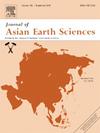Earthquake-induced permeability and hydrochemical variation in an aquifer–aquitard system
IF 2.7
3区 地球科学
Q2 GEOSCIENCES, MULTIDISCIPLINARY
引用次数: 0
Abstract
Groundwater level, permeability, and chemical components can be affected by earthquakes; however, there are few comprehensive investigations utilizing long-term continuous hydrological monitoring data covering multiple strong earthquakes. In this study, a continuous 2-year dataset of groundwater levels and chemical composition (Ca2+, Mg2+, HCO3−) from well #32 in the Xichang area of Sichuan Province, China, was used to analyze changes in earthquake-induced hydrological processes within an aquifer–aquitard system. Co-seismic changes in groundwater level and ion concentrations were associated with the Yangbi MW 6.1 and Luding MW 6.6 earthquakes. Horizontal and vertical permeability, estimated using the tidal response model, decreased during both earthquakes, possibly owing to dynamic strain resulting from seismic waves. In addition, there were significant correlations between vertical permeability and ion concentrations, with ion fluctuations during earthquake periods possibly associated with reduced mixing of different groundwater sources owing to the decrease in permeability. The results of this study provide new insight into the role of earthquakes in dynamic hydrological processes.
含水层-含水层系统的地震诱导渗透率和水化学变化
地下水位、渗透率和化学成分会受到地震的影响;然而,利用覆盖多次强震的长期连续水文监测资料进行的综合调查却很少。本研究利用四川西昌地区32号井连续2年的地下水水位和化学成分(Ca2+, Mg2+, HCO3−)数据,分析了地震引起的含水层-含水层系统水文过程的变化。地下水位和离子浓度的同震变化与杨壁mw6.1和泸定mw6.6地震有关。利用潮汐响应模型估计的水平和垂直渗透率在两次地震期间都有所下降,可能是由于地震波引起的动应变。此外,垂直渗透率与离子浓度之间存在显著相关性,地震期间的离子波动可能与渗透率降低导致不同地下水来源混合减少有关。本研究结果为地震在动态水文过程中的作用提供了新的认识。
本文章由计算机程序翻译,如有差异,请以英文原文为准。
求助全文
约1分钟内获得全文
求助全文
来源期刊

Journal of Asian Earth Sciences
地学-地球科学综合
CiteScore
5.90
自引率
10.00%
发文量
324
审稿时长
71 days
期刊介绍:
Journal of Asian Earth Sciences has an open access mirror journal Journal of Asian Earth Sciences: X, sharing the same aims and scope, editorial team, submission system and rigorous peer review.
The Journal of Asian Earth Sciences is an international interdisciplinary journal devoted to all aspects of research related to the solid Earth Sciences of Asia. The Journal publishes high quality, peer-reviewed scientific papers on the regional geology, tectonics, geochemistry and geophysics of Asia. It will be devoted primarily to research papers but short communications relating to new developments of broad interest, reviews and book reviews will also be included. Papers must have international appeal and should present work of more than local significance.
The scope includes deep processes of the Asian continent and its adjacent oceans; seismology and earthquakes; orogeny, magmatism, metamorphism and volcanism; growth, deformation and destruction of the Asian crust; crust-mantle interaction; evolution of life (early life, biostratigraphy, biogeography and mass-extinction); fluids, fluxes and reservoirs of mineral and energy resources; surface processes (weathering, erosion, transport and deposition of sediments) and resulting geomorphology; and the response of the Earth to global climate change as viewed within the Asian continent and surrounding oceans.
 求助内容:
求助内容: 应助结果提醒方式:
应助结果提醒方式:


